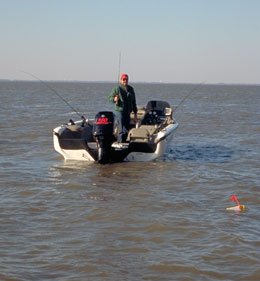Professional walleye angler Bill Leonard discusses the advantages of adding Off Shore planer boards to your walleye trolling arsenal.
 For quite a while now, there has been a controversy in the fishing world. The controversy? Instead of giving people needed information to help them become better at catching fish, are professional anglers simply doing commercials for the products they use? I don’t think there is a clear-cut yes or no for this controversy. The answer is, unfortunately, sometimes yes, sometimes no and sometimes kind of.
For quite a while now, there has been a controversy in the fishing world. The controversy? Instead of giving people needed information to help them become better at catching fish, are professional anglers simply doing commercials for the products they use? I don’t think there is a clear-cut yes or no for this controversy. The answer is, unfortunately, sometimes yes, sometimes no and sometimes kind of.
As a professional walleye fisherman, I understand the frustration of readers when the entire article or seminar sounds like a commercial. Yet, there are times when I think using product names are appropriate. To me, if somebody has success using a product, why not share that knowledge. That’s what this article is going to do. I want to cover information about planer boards, because I believe that the information will help you improve your fishing success.
Off Shore planer boards have been the industry leaders in the world of in-line planer boards, and I think that in-line planer boards have changed how we fish probably more than any single piece of equipment that we fish with.
For those who are unfamiliar with in-line planer boards, let’s take a minute to explain what they are and how they work. An Off Shore planer board is designed to move the bait you are trolling with away from the boat. How does it work? First, let your bait out behind the boat the distance at which you desire to troll it. Next, attach the line to the front snap of the planer board, but leave a little slack so that you can attach it to the back snap. Now, you are ready to release the board and let it go out to the side of the boat. How far depends upon several factors. Water clarity, how many boards you will be running at one time, how spooky the fish are and if there is wind, maybe the size of the waves.
I know on the pro walleye circuits, we have been using Off Shore in-line boards for over 10 years, and in that time, there have been several helpful little tricks developed.
With the new super braid lines like Fireline, the diameter of the line is so thin that it is difficult to get the standard snap on a planer board to stay on the line, while pulling the board and bait without slipping. To solve that problem, we’ve learned to double loop the front snap. In other words, open the snap, put the line through it, then loop it around the top of the snap and back through. This will definitely eliminate any slippage. When the water is calm, you can pull the Off Shore boards in any direction. However, we have found when there is heavy wind and high waves, always troll with the wind. However, with a light wind and small choppy waves and aggressive walleyes, I have found on occasion that going against the wind can really work. The jerky motion of the baits will sometimes create a strike.
The real benefit of the Off Shore planer board is that it gets the bait away from the boat. Often when trolling, we drive over the fish, and the boat pushes the fish off to the side where the boards and baits will be going over the top. How far out do we run the boards? If the water is clear and shallow, often times we’ll put them out 60-80 feet. Just think of the benefit. Normally, I can run four poles out the side of my boat and cover a path through the water column about 30 feet. Now, I can add four planer boards to those same lines and cover a path 150 feet wide. This definitely puts you in contact with more fish, simply because you will be covering more of the water column.
So, is this article a commercial? Maybe to some readers it is, but the bottom line is you now have another option to use for catching more walleyes. To me, that’s worth it!










